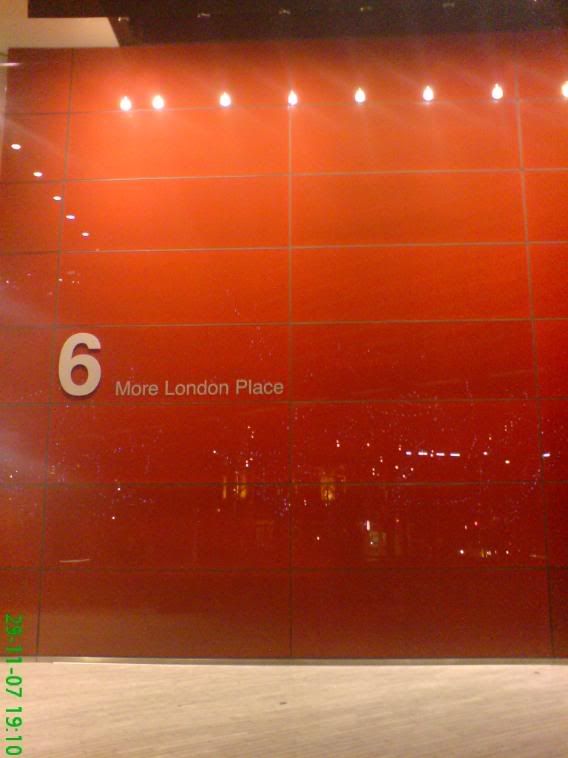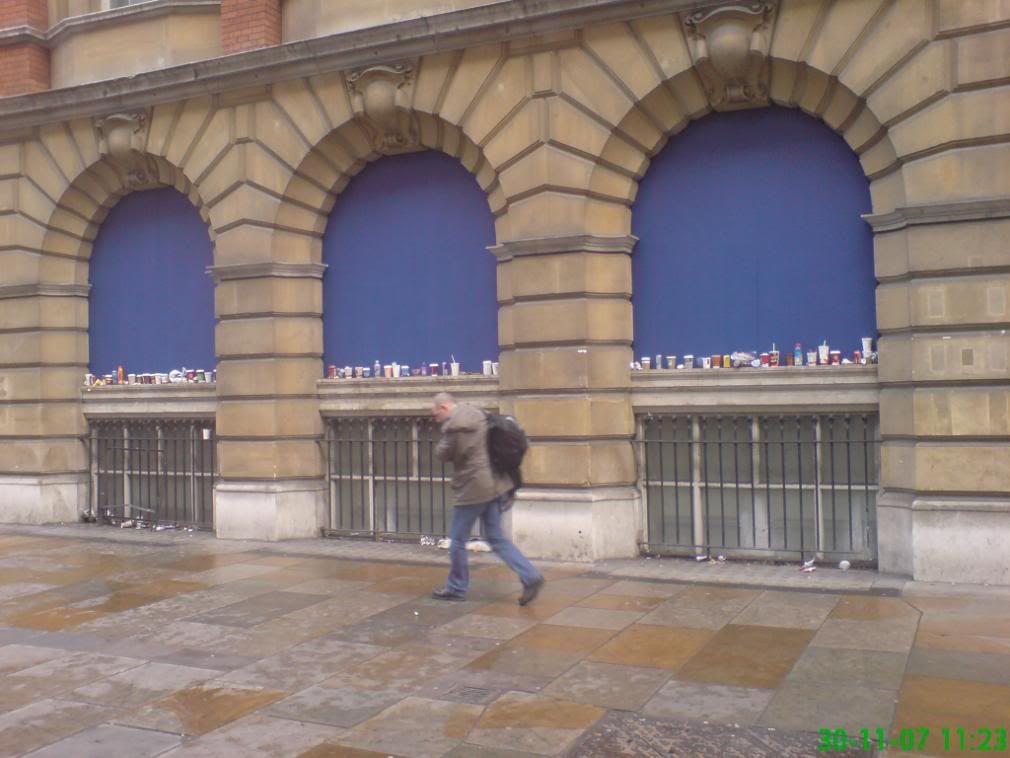A daily dose of odds and sods, some interesting, some bizarre, some funny, some thought provoking items which I have stumbled across the web. All to be taken with a grain of daily salt!!
Saturday, December 1
Innovation, Information, and Regulation in Financial Markets
But innovation does need to be managed as this speech says. It is long but very interesting, highly recommended to read the whole thing if you are worried about the state of financial markets.
Read and ponder.
Governor Randall S. Kroszner
At the Philadelphia Fed Policy Forum, Philadelphia, Pennsylvania
November 30, 2007
Innovation, Information, and Regulation in Financial Markets
Good afternoon. I am pleased to participate in the excellent annual Philadelphia Federal Reserve Policy Forum to discuss this year’s timely topic of innovations in financial markets. Innovations in financial markets have created a wide range of investment opportunities that allow capital to be allocated to its most productive uses and risks to be dispersed across a wide range of market participants. Yet, as we are now seeing, innovation can also create challenges if market participants face difficulties in valuing a new instrument because they realize that they do not have the information they need or if they are uncertain about the information they do have. In such situations, price discovery and liquidity in the market for those innovative products can become impaired.
In my remarks today, I would like to explore the role of information in the development of new financial products and then draw some lessons about risk management and regulation. In particular, I will examine the role that investment in information gathering, processing, and evaluating plays in supporting the price discovery process and how such investment can lead toward a tendency to greater standardization as markets for innovative financial products mature. Examples from both history and current experience will help to illustrate this tendency with respect to loan work-outs and restructurings. I will then conclude by considering how a regulatory approach that encourages transparency and sound risk management, such as Basel II, can be valuable in fostering a robust environment for the introduction of innovative financial products.
Experimentation and Learning in New Instrument Development
Typically, when a new product is being developed, there is an initial experimentation phase in which market participants learn a great deal about the product’s performance and risk characteristics. This phase involves gathering and processing information and modeling the performance of the product in various scenarios and under different market conditions. It may then take time for market participants to understand what, exactly, they need to know to value a product. During the early phases, a fair amount of due diligence is appropriate, given the greater uncertainty associated with innovative products. The investment in gathering, processing, and evaluating information then, as I will discuss, often leads to greater standardization of products and contract terms, which can enhance liquidity of products as their markets mature.
In the initial experimentation phase, the terms and characteristics of a new product are adjusted in response to market acceptance--or lack thereof. During this period, market participants are seeking and providing information so that they can properly value the product, judge its potential for risk and return, assess its market acceptance and liquidity, and determine the extent to which the risks of the product can be hedged or mitigated.
When a product’s track record is not well established, there should be a strong market demand for information in order to facilitate price discovery. Price discovery is the process by which buyers’ and sellers’ preferences, as well as any other available market information, result in the “discovery” of a price that will balance supply and demand and provide signals to market participants about how most efficiently to allocate resources. This market-determined price will, of course, be subject to change as new information becomes available, as preferences evolve, as expectations are revised, and as costs of production change.
In order for this process to work most effectively, market participants must utilize information relevant to value that product. Of course, searching out and using relevant sources of information--as well as determining what information is relevant--has its own costs. To underscore the last point, with new instruments, it may not even be clear exactly what information is needed for price discovery--that is, some market participants may not know what they do not know and they may therefore terminate the information-gathering stage prematurely, unwittingly bearing the risks and costs of incomplete information.
Price Discovery
Due diligence is an important part of the price discovery process. The due-diligence process allows market participants to “trust but verify” market-provided information through a range of activities, from assessing risks and exposures through stress-testing to assessing the enforceability of the contracts that define the legal relationship among originators, sponsors, investors, and guarantors. The due diligence is complemented by risk-management structures that allow participants to interpret, understand, and act appropriately in response to the information in the market.
Recently we have seen how a lack of information and inadequate due diligence and risk management have created problems in the market for certain structured finance products. Let me focus a moment on structured investment vehicles, or SIVs. SIVs have been created with a variety of terms and characteristics--for example, different underlying assets, different levels of liquidity support or guarantees, and various triggers that require the forced sale of assets or liquidation of the structure. Although SIVs or similar vehicles have existed for many years, many recent SIV structures involved a much higher level of complexity of the underlying credit risks, legal structures, and operations. This complexity--and the lack of information about where the underlying credit, legal, and operational risks resided--made these products more difficult and costly to value than many investors originally thought. Investors suddenly realized that they were much less informed than they assumed and, not surprisingly, they pulled back from the market.
We have seen similar problems in the subprime residential mortgage-backed securities market and the related derivatives markets. The lack of long historical data on the performance of these instruments, and their correlations with other assets and instruments, made it difficult to assess their overall risk-return profile, especially in times of stress. Moreover, in the subprime residential mortgage-backed securities market, many market participants were willing to proceed without conducting robust due diligence and without establishing appropriate risk-management structures and processes. They did not follow “trust but verify,” that is, they instead accepted the investment-grade ratings of these securities as substitutes for their own risk analysis. Ratings keyed to expected default or credit loss do not adequately capture the full range or magnitude of risks to which a product may be subject, including--as we have seen most dramatically--market liquidity risks. In addition, some originators may not have demanded sufficient information about the purchased assets underlying these structures and therefore may not have fully appreciated the credit risk of the assets and the consequential risk that the structures would come back on balance sheet when the assets defaulted.
When the problems in the subprime mortgage market began to emerge and delinquencies exceeded rating agency estimates and the defaults predicted by limited historical data, we had moved beyond our past experience with these instruments. Information was not readily available about the extent to which the economic context had changed, or even whether underlying loans would or could be modified to prevent default. When ratings were downgraded, investors lost confidence in the quality of the ratings and hence the quality of the information they had about subprime investments. Lack of information, a disrupted price-discovery process, and a stressed environment led to a reassessment of risk, not only in the subprime market but also in the residential mortgage market across the board.
Of course, this is not the first time that participants in a market for an innovative product have suffered losses. In the early 1990s, participants in the collateralized mortgage obligation (CMO) market and the markets for structured notes and certain types of interest rate derivatives did not have adequate information about the potential volatility and prepayment risk involved. Consequently, market participants did not appropriately model these risks and suffered significant losses when market interest rates rose sharply in the mid-1990s. As in the case of the residential mortgage-backed securities market today, the general market reaction was a flight away from these instruments. However, over time, the market was restored as market participants came to better understand the risks and as standardized methods were developed to measure the risks and model the value of these instruments under alternative scenarios. Increased information and standardized pricing conventions, such as the use of option-adjusted spreads, moved these instruments from the experimentation and learning phase to the phase of broad market acceptance.
When market participants realize that they do not have the information necessary for proper valuation of risks, the price-discovery process can be disrupted, and market liquidity can become impaired. A significant investment in information gathering, processing, and evaluation may be necessary to revive the price discovery process. This revival is likely to take time and the market may not look the same when it re-emerges.
Let me describe in a bit more detail the ways in which these investments will take place and hence why recovery of price discovery may be a gradual process. First, market participants will likely need to collect more-detailed data in a more systematic manner in order to better understand the nature and risks of the instruments and their underlying assets. Second, investments in enhanced systems to warehouse and model data related to these instruments will facilitate a better understanding of their risks, particularly under stress conditions. Third, investors need to ensure that they have the so-called human capital expertise--that is, the people--to understand, interpret, and act appropriately on the results of the modeling and analysis of the information gathered. The pay-off from these investments will be a greater understanding of risks and greater ability to value the instruments.
The Development of Greater Standardization in a Market
Another consequence of information investments is a tendency towards greater standardization of many of the aspects of an instrument, which can help to increase transparency and reduce complexity. As was demonstrated in the CMO market, as the market gains information about a product and develops a level of confidence in that information, the product tends to become increasingly standardized. Standardization in the terms and in the contractual rights and obligations of purchasers and sellers of the product reduces the need for market participants to engage in extensive efforts to obtain information and reduces the need to verify the information that is provided in the market through due diligence. Reduced information costs in turn lower transaction costs, thereby facilitating price discovery and enhancing market liquidity. Also, standardization can reduce legal risks because litigation over contract terms can result in case law that applies to similar situations, thus reducing uncertainty.
The benefits of the development of standardization for enhancing the liquidity of financial markets have a long history. One particularly clear example dates back to the development of exchange-traded commodities futures contracts in the mid-1800s. The standardization of the futures markets improved the flow of information to market participants, reducing transaction costs and fostering the emergence of liquid markets.
In the early days of the Chicago Board of Trade, in the mid-1850s, standardization took the form of creating “grades” or quality categories for commodities such as wheat, allowing for the fungibility of grains stored in elevators and warehouses, and breaking the link between ownership rights and specific lots of a physical commodity. Traders no longer needed to verify that a certain quantity of grain was of a sufficiently high grade because the exchange established a system of internal controls in the form of grain inspectors and a self-regulatory system to arbitrate disputes. The grain inspectors charged a set fee to certify the quality of the grain for any receipt traded at the board, a system with parallels to the mechanisms employed today by the rating agencies.1
In effect, standardization and related controls reduced traders’ information requirements and, thus, their transaction costs. In 1865, the Chicago Board of Trade standardized the delivery dates for the contracts, thus fostering the emergence of liquid markets in which traders could readily hedge the risk of price changes in the commodities and contracts. A final step toward standardization came years later with the adoption of the clearinghouse for the exchange as the common counterparty to all of the contracts traded on the exchange. With a central counterparty, the costs and uncertainties of failures and restructurings were significantly reduced, thereby reducing work-out costs and enhancing liquidity of the contracts traded on the exchange.2
The benefits of standardization can be realized not only on organized exchanges but also in over-the-counter markets. In more recent times, for example, the creation of the International Swaps and Derivatives Association (ISDA) master agreement for over-the-counter swaps and derivatives contracts has brought about the benefits of standardization while also allowing for product flexibility and customization. The ISDA master agreement provides standard definitions and a general outline for the contract but allows latitude in customizing terms. The master agreement also sets forth a template for workout procedures if a counterparty defaults, allowing parties to the agreement to adjust their risk-management strategies in light of the agreed-upon work-out process. This standardization reduces uncertainty about the instruments, which lowers transaction costs and facilitates price discovery and market liquidity.
The examples from the long- and more recent- past may hold some valuable lessons for how improvements in standardization could help to address some of the challenges in the subprime market. Uncertainty about the work-out process and the options that are available, for example, could be contributing to the difficulties in reviving price discovery and liquidity in the market for subprime residential mortgage-backed securities. Part of the valuation challenge is gauging the extent of the difficulties that borrowers will have in making payments and being able to stay in their homes given the reduction in house price appreciation--or actual declines in some areas--and the large number of interest rate resets coming on many adjustable-rate mortgages. From now until the end of next year, monthly payments for an average of roughly 450,000 subprime mortgages per quarter are scheduled to undergo their first interest rate reset. In addition, tightening credit conditions as reported in the Federal Reserve’s Senior Loan Officer Opinion Surveys on Bank Lending Practices suggest that refinancing may become more difficult.
Lenders and servicers generally would want to work with borrowers to avoid foreclosure, which, according to industry estimates, can lead to a loss of as much as 40 percent to 50 percent of the unpaid mortgage balance. Loss mitigation techniques that preserve homeownership are typically less costly than foreclosure, particularly when applied before default. Borrowers who have been current in their payments but could default after reset may be able to work with their lender or servicer to adjust their payments or otherwise change their loans to make them more manageable.
It is imperative that we work together as a financial services community to look for ways to help borrowers address their mortgage challenges, particularly for those who may have fewer alternatives, such as lower-income families. The Federal Reserve and other regulators have been active in encouraging lenders and servicers to take a proactive approach to work with borrowers who may be at risk of losing their homes. For example, the agencies have issued statements underscoring that prudent workout arrangements that are consistent with safe and sound lending practices are generally in the long-term best interest of both the investor and the borrower and have had numerous meetings with interested parties to foster the development and implementation of work-out arrangements.
Given the substantial number of resets from now through the end of 2008, I believe it would behoove the industry to go further than it has to join together and explore collaborative, creative efforts to develop prudent loan modification programs and other assistance to help large groups of borrowers systematically. I am not suggesting a one-size-fits-all approach, but a bottom-up approach designed to appropriately balance the needs of all parties. Getting to borrowers who have been making payments but are at risk of falling behind before they actually do become delinquent, for example, can help to preserve work-out and refinancing options.
Some industry participants and consumer groups have begun to work collaboratively to develop loan-modification templates, standards, and principles that can help to streamline the work-out and modification process. This can reduce transaction costs and potentially provide timely relief to a wider range of borrowers. A systematic approach to loan modifications would likely reduce some of the uncertainties in the market for such subprime mortgage-backed securities, helping to restore price-discovery and liquidity. This would help to ease the tightening of credit conditions in the market.
I am privileged to serve as a board member of NeighborWorks America, a national nonprofit that partners with the HOPE NOW Alliance. This alliance is developing ways to facilitate the flow of information between servicers and distressed borrowers and to work toward clarification of loan-modification procedures. Increased standardization and certainty could also benefit investors in the mortgage market by improving information flows and the price-discovery process, thereby improving market liquidity while at the same time helping to avoid foreclosures and promoting sustainable homeownership.
A Regulatory Environment That Encourages Sound Risk Management and Transparency
Recent market events have underscored the need for better market information about new products, robust due diligence to verify that information, and risk-management strategies to utilize the information in management decisionmaking. The supervisory agencies and the industry both are addressing the need for improved risk management in light of the market disruptions
The newly adopted Basel II capital framework for large internationally-active banking organizations, for example, is an important advance that encourages the types of investment in information I discussed earlier. The Basel II framework is comprised of three pillars. Pillar 1 requires information gathering and robust modeling techniques to better take into account the risks of different types of instruments and securities than under the traditional Basel I framework. It also provides incentives for more robust risk management in connection with certain higher-risk activities, such as securitization and other off-balance-sheet activities. Pillar 2 emphasizes the further stress testing and analysis of the data in conjunction with an ongoing evaluation of the institution’s capital adequacy in light of its risks through the internal capital adequacy assessment process. Pillar 3 reflects the need for better information through investments in data gathering and analysis that are reflected in enhanced public disclosures and regulatory reporting. More-comprehensive and more-transparent information allows investors to better understand the banking organization’s risk profile and thus reduces transaction costs and facilitates price discovery and market liquidity. The three pillars of Basel II promote precisely the three types of investment in information discussed earlier that facilitate the price discovery process.
In addition to supervisory initiatives, industry leaders’ efforts to influence the adoption of sound practices and codes of conduct can efficiently and effectively facilitate market-correcting behaviors. To this end, the industry is actively engaged in efforts to improve sound practices for risk management through improved stress-testing practices to cover contingent exposures, marketwide events, and potential contagion and enhanced due diligence and modeling for new products. As they look into the causes of the recent market disruptions and determine the appropriate response, both supervisory and industry groups are carefully analyzing the weaknesses in risk management and the lack of transparency in complex structures--and the implications of that lack of transparency for proper valuations.
Conclusion
The recent market disruptions have dramatically underscored the importance of gathering and analyzing information about innovative products. When the price-discovery process for a product is disrupted, both investors and sellers need to engage in a period of information gathering, processing, and analysis in order to re-establish a market price. This can be a gradual process and one that results in fundamental changes to the market for the product. Efforts underway by both supervisors and the industry should encourage improvements in risk analysis and management and, thus, price discovery. We are hopeful that our efforts to increase the standardization of loan-modification options and processes for subprime loans will help to provide more information to lenders, investors, homeowners, and communities faced with potential mortgage loan defaults while at the same time helping to provide more timely relief for borrowers in distress.
--------------------------------------------------------------------------------
Footnotes
1. See Randall S. Kroszner (1999), “Can the Financial Markets Privately Regulate Risk? The Development of Derivatives Clearing Houses and Recent Over-the-Counter Innovations,” Journal of Money, Credit, and Banking, vol. 31 (August), p. 600. Return to text
2. See Kroszner, “Can the Financial Markets Privately Regulate Risk?”, p. 601.
All this to be taken with a grain of piquant salt!!!
I no longer want to be a paperback reader
This appealed to me, but then, I have a problem. I find hardback books way too expensive for me. I came to the UK with 2 books way back in 1992, both paperback. Now I would say that 90% of my library is paperback. Purchasing hardbacks is a pain. I also went through a phase of using my Palm Pilot III, then Palm Pilot V, then Sony Clie to read e-books. I was rampaging through Gutenberg, purchasing cd's full of e-books off ebay and reading them on the tube. And then I fell out of the habit and went back to reading paper books!
But nice to read from a fellow logophilic! :)
Who went and made Frits Bolkestein an EU Commissioner?
I nearly choked on my morning cuppa tea when I read this letter from Frits Bolkestein in the FT. For those who do not know, this chap was a EU commissioner from 1999-2004. And he is, if I might be very impolite, rather anti-Muslim. His visceral antipathy towards the admission of Turkey is well known. But read the full letter here:
From Mr Frits Bolkestein.
Sir, The most important argument against Turkey's accession to the European Union is that it will lead to that of Ukraine, in the wake of which will come Belarus and Moldova, perhaps even Georgia, Armenia and Azerbaijan.
Together with the countries of the western Balkans this would result in an EU of more than 40 member states. The EU would be fatally diluted. It would be little more than a free-trade area, if that.
Two countries have always militated in favour of the accession of Turkey: the US and the UK. The US takes this position for reasons of geopolitics, even though the Turks have not exactly been helpful in the US-led war against Iraq. Mexico joining the US may well be compared with Turkey joining the EU. The US is now building a wall to keep out unwanted Mexican immigrants.
Why is the UK so enthusiastic about Turkey's accession? Cynics say: “Because it wants to dilute the EU, which it has never liked.” Is this allegation true or is it slander?
Now we know the answer. On November 15 David Miliband, the UK foreign secretary, gave a speech at the fateful place of Bruges, Belgium. It was on Europe in the year 2030. Mr Miliband's priority was enlargement. He wanted to take the European Neighbourhood Policy, which now concerns only non-members, a step further.
He said: "We must clearly state that participation [in the ENP] is not an alternative to membership or a waiting room." For good measure he went on to say: "The goal must be a multilateral free trade zone ... that could gradually bring the countries of the Maghreb, the Middle East and eastern Europe in line with the single market, not as an alternative to membership but potentially as a step towards it (emphasis added).
The mind boggles. Somebody once said that Britain had neither permanent friends nor permanent enemies, only permanent interests. Mr Miliband has now told us that it is in the permanent interest of the UK fatally to dilute the European Union.
Frits Bolkestein,
Member of the European Commission 1999-2004
Now why on earth would he moan about a fatal dilution when the original EU has grown from the original 6 members to the current 27. Now you see why I say that the European Elite are anti-Muslim? or anti Turkey at the least? It is primarily due to the fright of letting such a large Muslim population inside the boundaries that is causing them heeby jeebies.
Given the current challenges with Muslim minorities in almost every country (UK, Germany, Netherlands, France, Switzerland, Sweden, Denmark - all explored here on this blog), I am not surprised that European Elites are now worried sick at the thought of committing what i would call as immigration led religious and cultural hara kiri. The normally passive European population will rise up, but typically, they are blaming the British for asking the Turks to get in!, what intellectual dishonesty!
Politics of Identity in Malaysia
The fact that the primary politics of Malaysia are racist at worst and discriminatory at best is not in doubt. The national ethos is oriented towards the protection of privileges towards the majority Malay and devil take the minorities.
But that's pretty much standard and par for the course. See here for a longer essay on this. So whenever Malaysian leaders (Like that Mahatir Mohammad clown) say anything, I automatically read it with jaundiced eyes simply because of the inherent racism and discrimination on which they rest their arguments about Muslims, Malays, Asian Values or what have you.
But as I keep on saying here and everywhere, if you rely on having a legal and political system which is biased towards one group and/or another, then you will soon come to a clashing break with the minorities or those who call themselves say, OIY, hold on, why are you discriminating against ME?
I do realise there are many more sub-strands to this discussion about identity in Malaysia (such as Indian origin Muslims siding with Malay Muslims rather than Indian Hindu's, Indian Sikh and Gujerati origin Malaysians keeping away from everybody, the Han Chinese keeping silent (ish) and forming their own community, the links with Singapore and Malaysia, the colonial links, the still burning embers of the old communist rebellion, the failure of the bhumiputra policy.....)
This is even more visible in the days of transparency and 24 hour communications that any form of inequality or discrimination is very quickly shown up. But I would like to make two more points before heading into the article:
1. Why is China not squeaking about its progeny in Malaysia and why is Chinese Media, controlled though it is, not moaning about it as the Indian Media is? I do not have a reason per se' but the Chinese have a rather different viewpoint of nationality and the diaspora. The concept of the "middle kingdom" and the sheer numbers means that Beijing rarely bothers about diaspora Chinese. In fact, I dont recall any instance in recent memory that China has moaned about ethnic Chinese of another nationality or state.
2. If the Indians do decide to do a LTTE Style terrorist campaign or even decide do escalate the current Gandhigiri campaign to a more long term campaign, (specially if the official reaction is like this), then it is my gut feel that the current "moderate-Muslim" Malay regime will collapse very quickly and a far more hardline Muslim state will form in Malaysia.
So when my friend, Aditi Bhaduri, sent me this essay which I am copying here, I nodded rather cynically.
Read and laugh at those Malay Muslim Leaders.
Read and laugh at those Malay Muslim Leaders.
OVERSEAS AND UNHAPPY
- India needs to pay attention to the ethnic crisis in Malaysia
Sunanda K. Datta-Ray

Not Silicon Valley
Malaysia's simmering ethnic crisis is something for the ministry of overseas Indian affairs to ponder on. Presumably, the Pravasi Bharatiya Samman was bestowed on S. Samy Vellu, president since 1979 of the Malaysian Indian Congress and public works minister in the ruling coalition, because India approves of his work as representative of more than two million ethnic Indians. Since the man and his constituency are inseparable, convulsions in the latter that question his leadership oblige India to reassess its attitude towards the diaspora.
Initially, screaming headlines about Hindus on the march suggested hordes of ash-smeared trident-brandishing sadhus with matted locks rampaging to overwhelm Muslim Malaysia. In reality, thousands of impoverished Tamils carrying crudely drawn pictures of Gandhi sought only to hand over a petition to the British high commission in Kuala Lumpur about their plight since their ancestors were imported as indentured labour 150 years ago. It so happened that the Hindu Rights Action Force (Hindraf), a new umbrella group of 30 organizations, mobilized Sunday's protest when Tamils battled the riot police for six hours.
The confrontation was even farther removed in space than in time from Lee Kuan Yew's claim in 1959, when Singapore was waiting to join Malaya, that India was to Malayan culture "what Greece and Rome are to Western culture". Peninsular Malay was part first of the Srivijaya empire and then of Rajendra Chola's overseas dominions. Even modern Islamic Malaysia borrows heavily from India. Terms like Bangsa Melayu (for the Malay nation) and bumiputera (Malay Muslims), the cherished determinant of political and economic privilege, expose Malaysia's own unacknowledged linguistic bankruptcy.
Describing the Thirties excavations in Kedah, which confirmed that Bujang was a Srivijaya empire port — dating back to the 4th century — within easy sailing distance of India, Time magazine reported in 2000, "But an Indian Malaysian visiting the Bujang Valley might come away feeling demeaned rather than proud — and that would be no accident." Anthony Spaeth, the writer, went on to say that "the official literature does its best to downplay, even denigrate, the Indian impact on the region".
Ironically, the Indian minority's further marginalization coincided with the long tenure (1981-2003) of the former prime minister, the ethnic Indian medical doctor, Mahathir Mohamad. He also took Malaysia further along the road to Islamization. A kind of competitive Islam was at play under him with the fundamentalist Parti Islam SeMalaysia demanding Sharia law and Mahathir's subsequently disgraced lieutenant, Anwar Ibrahim, peddling what he called Islamic values without "Arabisation".
Lee says Chinese Malaysians (25 per cent) who have maintained an uneasy peace since the vicious Malay-Chinese riots of 1969, are being marginalized. But they at least have someone to speak up for them. They are also able to salt away their savings in Singapore where they often send their children for education and employment. Lacking any of these fall-back advantages, the much poorer Indians suffered in silence until Sunday's upsurge. They did not protest even when six Indians were murdered and 42 others injured in March 2001 without the authorities bothering to investigate the attacks.
Nearly 85 per cent of Indian Malaysians are Tamil, and about 60 per cent of them are descended from plantation workers. Official statistics say Indians own 1.2 per cent of traded equity (40 per cent is held by the Chinese) though they constitute eight per cent of the population. About 5 per cent of civil servants are said to be Indian while 77 per cent are Malay. An Indian who wants to start a business must not only engage a bumiputera partner but also fork out the latter's 30 per cent share of equity. The licence-permit raj has run amok with government sanction needed even to collect garbage. Lowest in the education and income rankings, Indians lead the list of suicides, drug offenders and jailed criminals. All the telltale signs of an underclass. While the state gives preferential treatment to bumiputeras, the MIC has done little to help Indians rise above their initially low socio-economic base.
Religious devotion often being the last refuge of those with little else to call their own, Indians set great store by their temples, which are now the targets of government demolition squads. Many are technically illegal structures because the authorities will not clear registration applications. The last straw was the eve-of-Diwali destruction of a 36-year-old temple in Shah Alam town which is projected as an "Islamic City". Insult was piled on injury when, having announced that he would not keep the customary post-Eid open house as a mute mark of protest, Vellu hastily backtracked as soon as the prime minister frowned at him.
Emotions have been simmering since 2005 when the mullahs seized the body of a 36-year-old Tamil Hindu soldier and mountaineer, M. Moorthy, and buried it over the protests of his Hindu wife, claiming Moorthy had converted to Islam. A Sharia court upheld the mullahs, and when the widow appealed, a civil judge ruled that Article 121(1A) of Malaysia's constitution made the Sharia court's verdict final. Civil courts had no jurisdiction. Such restrictions and, even more, the manner in which rules are implemented, make a mockery of the constitution's Article 3(1) that "other religions may be practised in peace and harmony".
Last Sunday's petition was signed by 1,00,000 Indians. The fact that it was provoked by a supposed conversion and a temple destruction and was sponsored by Hindraf prompted P. Ramasamy, a local academic, to say, "The character of struggle has changed. It has taken on a Hindu form — Hinduism versus Islam." But that is a simplification. The protesters who were beaten up, arrested and charged with sedition were Indians. They were labelled Hindu because Tamil or Malayali Muslims (like Mahathir) go to extraordinary lengths to deny their Indian ancestry and wangle their way into the petted and pampered bumiputera preserve. In Singapore, too, Indian Muslims who speak Tamil at home or sport Gujarati names drape the headscarf called tudung on their wives and insist they are Malay. Malaysia's Sikhs also distance themselves from the Indian definition which has become a metaphor for backwardness.
Branding Sunday's demonstration Hindu automatically singles out the minority as the adversary in a country whose leaders stress their Islamic identity. The implication of a religious motivation also distracts attention from the more serious economic discrimination that lies at the heart of minority discontent. Acknowledging that "unhappiness with their status in society was a real issue" for the protesters, even The New Straits Times, voice of the Malay establishment, commented editorially, "The marginalisation of the Indian community, the neglect of their concerns and the alienation of their youth must be urgently addressed."
Some have suggested that the illusory prospect of fat damages from Hindraf's $4 trillion lawsuit against the British government may have tempted demonstrators. But the lawyers who lead Hindraf must know that their plaint is only a symbolic gesture like my Australian aboriginal friend Paul Coe landing in England and taking possession of it as terra nullius (nobody's land) because that is what the British did in Australia. The more serious message is, as The New Straits Times wrote, that secular grievances must be addressed. Though plantation workers have demonstrated earlier against employers, never before have they so powerfully proclaimed their dissatisfaction with the government. In doing so, under Hindraf colours, they have also signified a loss of confidence in Vellu and the MIC. The worm has turned. There is a danger now of the government hitting back hard.
All this concerns India, not because of M. Karunanidhi's fulminations but because interest in overseas Indians must be even-handed. The diaspora does not begin and end with Silicon Valley millionaires. Nor should Vayalar Ravi's only concern be V.S. Naipaul and Lakshmi Mittal whose pictures adorn his ministry's website. Indians of another class are in much greater need of his attention.
More London, Not so sure I am taken with it
I was at More London and it is a new development. Not very impressed but there you go!
You can see the Tower Bridge in the background and that strange curved London Mayor Building in the background.

The Christmas lights and the shallow fountain pools looked good.






They had some nicely colourful buildings on the other side of the Hilton.




There is a restaurant on the left, its a very nice place, but I have forgotten the name. There is also a great Argentinean Beef Place (Gaucho's) around the corner, so if you are ever in London, do let me know and I will take you with me.

Barbican Station - What a grotty place
Barbican Estate is an eyesore, its a carbuncle on the face of London. If you don’t believe me, see these pictures I took in the morning from the Barbican Tube Station Platform when the tube was (as usual) again delayed.



How can people live up in that pigeonhole, concrete prick of a tower, I don?t understand.
A Tower without a church or bells
This was the saddest sight that I could see. A Church Tower, isolated in the middle of a street, with an office building on one side and a police station on the other. It is actually a house now! Very sad and interesting at the same time!!!!





Two London Pictures
A picture of London which shows variously how bad road cleaning in London is, how an amazing composition is made up from coffee and drinking ups and well, this is London! :)
Took this photo yesterday morning!

Friday, November 30
Abraham Lincoln - the constitutional President? Nope!
Anyway, read and scratch chin
Daniel Farber. _Lincoln's Constitution_. Chicago: University of Chicago
Press, 2003. ix + 240 pp. Notes, bibliography, index. $27.50 (cloth),
ISBN 978-0-226-23793-0.
Reviewed for H-CivWar by Brian Flanagan, Hauenstein Center for Presidential Studies, Grand Valley State University
Abraham Lincoln, _Praetor Maximus_
Examples abound in history, of leaders who have taken on dictatorial powers at the expense of constitutional order--Lucius Cornelius Sulla and Julius Caesar in classical Rome; Mao Zedong, Joseph Stalin, Hideki Tojo, Adolf Hitler, and Benito Mussolini in modern Europe and Asia. It would come as a shock to the sensibilities of most Americans who revere their sixteenth president that Abraham Lincoln is often placed in the
company of such leaders. As we approach the bicentennial of Lincoln's birth, it is important to remember that throughout the Civil War he took actions that were viewed by many of his contemporaries--and are still viewed by many scholars--as beyond the limits of _ordinary_ presidential authority, as perhaps dictatorial.
In 1861, after the South's attack on Fort Sumter, newly inaugurated President Lincoln opted for several counter-offensives that fell squarely within Article I of the United States Constitution, describing the national legislature's authority--not the president's. He blockaded Southern ports (effectively declaring a state of war); suspended _habeas corpus_ between Washington D.C. and Philadelphia, and eventually across
the North; expanded the regular army and navy; and ordered the U.S. Treasury to advance two million dollars to a private firm in New York for discretionary use on war supplies. Later he instituted military trials across North and South to dispense justice and ignored a Supreme Court directive challenging his authority to suspend the writ. Even the Emancipation Proclamation, Lincoln himself admitted, would have been
beyond his authority in peacetime.
But 1861-65 was a time of rebellion--of Civil War--in the United States. How does this _extraordinary_ circumstance change the legal implications of Lincoln's actions?
Enter Daniel Farber.
Farber's book, _Lincoln's Constitution_, could justifiably be re-titled
"Lincoln's Constitutionality"(at the expense of the author's double
entendre): it is more correctly characterized as an assessment of the
legality of Lincoln's presidency than as an analysis of his
interpretation (or reinterpretation) of the U.S. Constitution. In fact,
this is one notable limit to Farber's legal history of the executive
administration of the Civil War. He does not consider, as Garry Wills
has, the significance of the Gettysburg Address in changing the
Constitution by cleansing it of "that legal compromise" over the issue
of slavery and by appealing instead to its "spirit," its moral root in
the Declaration of Independence.[1] Except in passing, he does not
consider, as David Herbert Donald has, Lincoln's Whig understanding of the Constitution that actually _weakened_ the executive branch in
relation to Congress and the cabinet, even if in war decisions it tended toward John Quincy Adams's expansive view that, "by the laws of war an invaded country has all its laws and municipal institutions swept by the board, and martial law takes the place of them.... Whether the war be civil, servile, or foreign ... the military authority takes for the time the place of all municipal institutions, slavery among the rest."[2]
Farber's analysis of Lincoln's abidance by constitutional law,
congressional statute, presidential precedent, and Supreme Court ruling is exhaustive. With the possible exception of J. G. Randall, no scholar to date has made as thorough a study of Lincoln's war measures in light of American law. More limited analyses have stopped at the (accurate) assertion that Lincoln himself never claimed his sweeping use of power was ordinarily legal. In essence, he went stovepipe hat in hand to a special session of Congress to ask ratification of his otherwise extralegal usurpation of congressional authority:
"These measures, whether strictly legal or not, were ventured upon,
under what appeared to be a popular demand, and a public necessity; trusting, then as now, that Congress would readily ratify them. It is believed that nothing has been done beyond the constitutional competency of Congress."[3]
More limited analyses have pointed to Congress's August 1861
ratification of Lincoln's actions, the Supreme Court's March 1863 _Prize Cases_ decision upholding the legality of his early war measures, and Congress's 1863 Habeas Corpus Indemnity Act, which retroactively authorized all arrests and seizures made under authority of the president.
More limited analyses have gone back further to emphasize the 1787
Constitutional Convention's decision to replace Congress's authority to "make" war with its authority to "declare" war, leaving it to the
president to repel sudden attacks. Much more limited analyses have
claimed broad, inherent, executive war powers--out of reach of the
legislative and judicial branches--and other exclusively presidential
prerogatives deduced from Article II clauses of the United States
Constitution. These analyses have used the uncharacteristic claim of a preeminent constructionist, Thomas Jefferson, that jeopardizing the nation's "very high interests ... by scrupulous adherence to written law, would be to lose the law itself ... thus absurdly sacrificing the end to the means."[4] Or they have used Lincoln's refrain defending suspension of the writ, "are all the laws, but one, to go unexecuted, and the government itself go to pieces, lest that one be violated?"[5] Together, these arguments can be used to make a strong case for the constitutionality of Lincoln's war measures, and all are assessed by Farber--most of them in one chapter.
But it is important--especially as debates persist today over the
balance between national security and individual rights, presidential
and congressional authority, national and state sovereignty--to remember that Lincoln's presidency was extraordinary in our history. It is important, as we read presidential historian Michael Beschloss
trumpeting the supreme value of presidential courage, to look closer at Lincoln's actions and understand where at crucial moments he probably overstepped his authority--even if he has been vindicated by history.[6] It is important, as Lincoln scholar Vernon Orville Burton pins the roots of an "imperial presidency" in the sixteenth president's "cavalier" approach to civil liberties, to recognize where the president was squarely within his legal bounds and where he showed great restraint.[7]
For this, we can return to Daniel Farber's legal history of Lincoln's
war decisions. Farber, the Sho Sato Professor of Law at the University of California, Berkeley, and McKnight Presidential Professor of Law at the University of Minnesota, has given us a disciplined and fair look at the sixteenth president's most controversial decisions. Farber considers a wide range of arguments both defending and condemning Lincoln: from his pre-presidential conclusion that secession was indeed illegal--that the federal government had authority to coerce state governments into
recognizing the supreme law of the land--to his exercise of powers
ordinarily reserved by Congress, to his administration's infringements on individual liberties in North and South. The author is decisive where possible but allows uncertainty to remain where it must--particularly on constitutional questions of "original intent" that the framers themselves debated until their deaths.
Farber's conclusions, overall, are favorable to Lincoln's legacy. With
the exception of some prominent freedom of speech infringements and cases of unjustified abridgement of individual rights in the North, most of what Lincoln did was strictly constitutional, falling within explicit presidential or congressional authority. It is a vital distinction, of course, that Lincoln's use of congressional powers--though probably necessary and in line with the "classic liberal view of emergency power"--were "approved and in all respects legalized and made valid" by Congress (p. 194). "Nowhere was there any thought," writes Farber, "that necessity alone gave the president an exemption from the legal consequences of violating statutory or constitutional requirements. Lincoln does not seem to have claimed such legal authority" (p. 195). Instead, Lincoln was retroactively granted executive and legislative prerogative to deal with the consequences of rebellion in the South.
Such being the case, Abraham Lincoln's accusers turn out to be right. In the classical Roman sense, he may accurately be called a dictator--a _praetor maximus_--vested temporarily with extraordinary power to deal with crisis. It is lucky, Farber reminds us, that at the crucial moment a man of "unshakable determination, combined with a shrewd sense of reality" was available to lead (p. 199).
Notes
[1]. Garry Wills, _Lincoln at Gettysburg: The Words That Remade America_ (New York: Simon & Schuster, 1992), 38.
[2]. Charles Francis Adams, "The Sifted Grain and the Grain Sifters,"
_American Historical Review_ 6, no. 2 (1901): 233.
[3]. Lincoln's Special Session Message, July 4, 1861, _Messages and
Papers of the Presidents_ (New York: Bureau of National Literature,
1897), 7: 3225.
[4]. Thomas Jefferson to John B. Colvin, September 20, 1810, _Works of Thomas Jefferson_ (New York: G. P. Putnam's Sons, 1905), 11: 146.
[5]. Lincoln's Special Session Message, July 4, 1861, _Messages and
Papers of the Presidents_ (New York: Bureau of National Literature,
1897), 7: 3226.
[6]. Michael Beschloss, _Presidential Courage: Brave Leaders and How They Changed America, 1789-1989_ (New York: Simon & Schuster, 2007), ix.
[7]. Vernon Orville Burton, _The Age of Lincoln_ (New York: Hill and
Wang, 2007), 225.
All this to be taken with a grain of piquant salt!!!
Christian Missionaries and the British Empire!- A Book Review
Here's a review of a recent book on this topic (and it has gone into my amazon wish list!:)):
Read and ponder about how the links of religion and state still exist.
Andrew Porter. _Religion versus Empire? British Protestant Missionaries
and Overseas Expansion, 1700-1914_. Manchester: Manchester University
Press, 2004. xviii + 373 pp. Maps, index. $74.95 (cloth), ISBN
978-0-7190-2822-9; $31.95 (paper), ISBN 978-0-7190-2823-6.
Reviewed for H-Albion by Roger B. Beck, Department of History, Eastern Illinois University
God and Caesar
It seems so simple. As Jesus said in the Gospels, "Render unto Caesar
the things that are Caesar's, and unto God the things that are God's"
(Luke 20:25). But for the Christian missionaries who went forth to
spread the gospel in "heathen lands," Caesar was always nearby, and it
was not always clear who was due what.
In _Religion versus Empire_, Andrew Porter is concerned with this
question from the outset: "The subject of this book is at once the
entanglement of British missions with Britain's empire and the extent of
their separate development" (p. 1). Porter provides a vivid illustration
of this tight intertwining of empire and mission in an example from
South Africa. As the first four London Missionary Society missionaries
were leaving for Cape Town, they found themselves without a ship and
having to ask for imperial assistance. They eventually sailed on the
convict transport, _Hillsborough_, bound for Botany Bay, arriving at the
Cape in March 1799. Porter reflects that their dependence on this free
passage represents in a stark but simple way "the impossibility for
missionaries of escaping the embrace of government, whatever illusions
they might entertain as to the likelihood or desirability of
independence." They had the "expectation that they could take advantage
of a government offer or facilities (however apparently 'providential')
without risk of compromise or obligation," and Porter observes that such
naïve notions proved to be "perennially recurring features of
missionary thinking and much traveled pathways to 'political'
involvement with government" (p. 76).
Porter also seeks to perform a much needed amalgamation of three
"relatively distinct and enormous literatures, the first on Britain's
imperial history, another on Britain's domestic religious and
ecclesiastical past and that concerned with the local histories of
distinct regions or colonial societies around the globe." These three
literatures have evolved quite distinctly and yet the study of
"Christian missionary expansion, whether as agents of British expansion
overseas, as expressions of popular and provincial British religious
commitment or as a critical influence in shaping local politics and
identities," has the potential to both broaden our knowledge of each
area, and also erect bridges between and among all three (p. 7).
This tour-de-force by the Rhodes Professor of Imperial History at King's
College, London, is the most definitive account to date of British
imperial expansion working, and not working, hand-in-hand with the
creation and expansion of international British missionary networks.
These networks are the central focus of Porter's narrative, a narrative
that reaches back into the eighteenth century and forward into the
twentieth, to present a complete picture of this imperial dance.
Porter begins with a broad overview of missionary practices and
precedents from 1701 to 1789. The majority of recent British missionary
scholarship focuses on the period after the publication of William
Carey's famous essay, _An Enquiry into the Obligations of Christians, to
use means for the Conversion of the Heathens_, in 1792, and his
departure on mission to India in 1793. Carey's essay marked the
beginning of the modern Protestant missionary activity; that is,
missions primarily to Africa, India, and Asia, particularly China.
Porter returns us to an earlier period to review British missionary
activity among the Indians and Africans in the American colonies to
demonstrate that "by the time Carey set sail, developments in Britain's
Atlantic and Caribbean colonies had long and amply illustrated the chief
missionary problems and possibilities which were constantly to recur and
shape the connections of missions and empire" (p. 16).
Porter's second chapter looks at the reorganization of missionary
enterprise from 1790 to 1812, a period when British interests begin to
expand around the globe and a re-evaluation was made of how to interact
with the native peoples they met and what responsibilities they had
toward them. For many Christians, but not all, it was clear that
Christianity had to be carried to these foreign lands, and it is during
this period that many of the great missionary societies were formed:
Carey's Baptist Missionary Society (1792); the London Missionary Society
(1795); the Edinburgh (Scottish) and Glasgow Missionary Society (1796);
and the forerunner of the Church Missionary Society (1799). In this
period, the links between imperial expansion and missionary expansion
were quite tenuous. Both groups were feeling their way literally through
new territory. Porter's observes that "in this period it is difficult
not to be struck by the comparatively insignificant place occupied by
empire in the minds of many evangelicals. To a degree that at times
could leave onlookers quite bemused and evangelicals themselves open to
ridicule, their thinking was dominated by the concept of an
all-embracing, superintending Providence" (pp. 58-59). The youthful
exuberance and sense of enthusiasm in spreading the Gospel is evident in
all the missionary literature of the time. There are very few doubts
about the rightness of the mission, and little thought given to empire,
unless it be the Kingdom of God.
In chapter 3, Porter reviews the development of the initial terms of
engagement between British mission and empire from 1800-30. By the
beginning of the 1800s missionaries were discussing the question of
whether to "follow the flag" or to strike out on their own. "Colonialism
was by no means necessarily conductive to missionary activity" (p. 64),
but these newly formed organizations, under funded, understaffed and
with very limited knowledge of the world, frequently had little choice
but to follow the flag. Hopping a transport ship, as the South African
example above illustrates, was often the only option available. "There
was to be no escape for the missions," Porter notes, "from encounter and
engagement with, even dependence on, governments, whether imperial or
colonial. At first, however, neither side sensed where events were
leading and neither state nor mission societies wanted dealings with
each other" (p. 65).
In chapter 4, Porter connects the three fields of historical
study--imperial, British domestic, and overseas local--with missionary
activity from 1800 to 1835. One example he cites is that of Dr. John
Philip and his battle with both the local British imperial officials at
the Cape and the local white settlers over black labor and black rights.
In this instance, Philip appealed back to Britain, where the
increasingly powerful London Missionary Society and the Clapham Sect
could influence domestic opinion and support Philip's pleas to
Parliament. Most of the missionary societies gained strength and
membership during this period and this growth related to the "continuing
debate about the meaning of 'civilization' and especially the
possibility of civilizing, or improving the conditions of, non-European
peoples" (p. 92). The debate soon encompassed the "three
C's"--Christianity, civilization, and commerce--and the questions as to
which of the three "either could, or should, be introduced first, in
what forms and with what degree of overlap" (p. 93).
By 1850, there were in place global networks of British Protestant
mission activity. In chapter 5, Porter describes how these networks
developed between 1814 and 1850, "fostered by the active pursuit of
common goals and the intermarriage of members of missionary families"
(p. 117). These global networks were part of a general expansion and, as
Porter calls it, a "new wave" of missionary activity that occurred in
the 1830s, 1840s, and 1850s. This "new wave" was due, as Porter shows in
chapter 6, to the fact that the missionary societies "were riding high
on the back of the humanitarian tide" during that period (p. 137). By
mid-century, however, the enthusiasm and excitement of the earlier days
were waning as it became more and more evident that the primary goal of
bringing indigenous individuals to Christ was not succeeding as rapidly
as planned or expected. In chapter 7, Porter discusses how the search
for converts and success or failure "always reflected local social and
political conditions" (p. 164). And even in those places where
conversion had been somewhat successful, little consideration had been
given to the configuration of the indigenous churches, the future roles
of the converts in those churches, or indeed, the future of the missions
themselves.
In chapter 8, Porter focuses on the development of the "faith" missions
in the second half of the nineteenth century as one response to the
decline in support and enthusiasm felt at mid-century. These evolved
from a desire to return to a simpler approach to mission work, and
reforms included the replacement of the term "missionary society" with
"mission," the dismantlement of the societies' home organizations, and a
straightforward approach to fundraising that took in donations and sent
them directly out into the field. Theologically there was a shift as
well. Missionary societies in the first half of the century generally
held a post-millennial ideal that expected missionary activity to aid in
the ushering in of Christ's Second Coming, and was rooted in the
Enlightenment ideas of progress. This post-millennial ideal was replaced
in some quarters in the second half of the century by a pre-millennial
ideal that viewed the world more pessimistically and expected "Christ's
imminent return to judgment, _after_ which the millennium would dawn.
For the missionary the pre-millennialist imperative was to push ahead
with evangelism on the widest possible front before the Second Coming
occurred" (p. 194). A common characteristic of these faith missions was
"a determination to operate in isolated and unfamiliar territory, as far
as possible beyond any European influence or colonial rule and at a
distance from other missionary bodies" (p. 224). China, the interior of
Africa, and the Muslim world all became prime targets of faith mission
activity. Thus while it has been the fashion for historians to perceive
closer links between the missionary effort and imperialism in the second
half of the nineteenth century, Porter shows that "many missions devised
wholly different plans for recovery and advance" (p. 224).
Despite the wide appeal of the faith missions, from 1860 to 1895 "for
most evangelicals ... the future lay not in wholesale rejection of the
recent past and the mounting of new kinds of mission but in the revival
and adaptation of existing and more familiar traditions" (p. 225). In
chapter 9, Porter describes the strategies and activities of the two
wings of evangelical Anglicanism represented by the Universities'
Mission to Central Africa and the Church Missionary Society. Chapter 10
is a wide-ranging discussion of missionary activity during the high age
of imperialism that demonstrates how little British imperial motives in
this period corresponded with the theory and practice of mission. As the
century drew to a close then, "an important part of the missionary
movement's attempts to sustain its appeal and generate renewed support
thus involved its re-appropriation of the secular humanitarian goals so
significant to its progress in the first half of the nineteenth century"
(p. 315).
These secular humanitarian goals, Porter argues in chapter 11, gave rise
to a significant degree of "anti-imperialism" among Protestant missions
in the two decades before the Great War. Missionaries held to a
continued belief in the fundamental unity of humanity. This belief put
them at odds with the racist and Social Darwinian theorizing evolving as
the imperialist scramble reached its zenith. In his final chapter,
Porter reflects on the broad conclusions that might be drawn from his
study, and what directions future research might take. In the end, and
as the reference to giving unto Caesar at the beginning of this review
suggests, "missionaries might not advocate empire, but were often
associated with institutions or beliefs identified by local peoples with
imperialism" (p. 316). But, as Porter demonstrates in this sweeping
analysis of the connections and disjunctions between religion and
empire, "although missions could not avoid empire, they were determined
to put it in its place" (p. 330).
All this to be taken with a grain of piquant salt!!!
The Curious CEO: Four Keys to Becoming a Great Leader
Read and Remember!
- Reading Outside Their Industry. It’s easy to immerse yourself in one vertical area of business knowledge. But the best CEOs read books and magazines outside their narrow business focus. They’re trying to find trends that are going to hit their company in coming years. And they’re looking to adjacent fields to find tips on how other industries are coping with a particular problem.
- Exposure to Networking Groups. The best CEOs expose themselves to other corporate leaders in non-profit settings or organizations like the Young Presidents Organization. And in those environments, they are constantly hungry for best practices.
- They Don’t Wall Themselves Off. The most curious and therefore best CEOs make sure that they have exposure to people in their private and social lives who can speak the truth to them, even if it’s uncomfortable. They don’t fall into the CEO Trap where the only things you hear are the things that people beneath you want you to hear.
- Avoiding the Arrogance Trap. A corollary is never becoming arrogant, never assuming that he or she knows everything. When a whole organization knows that a CEO is curious and is open to learning, that shapes the culure of the whole company. But when a CEO projects arrogance, the whole company shuts down and stops learning. The personality and behavior of the CEO is so crucial–it cascades throughout the organization.
All this to be taken with a grain of piquant salt!!!
Sudanese demand the death penalty for teddy bear teacher
According to some agencies, some of the protesters chanted: "Shame, shame on the UK", "No tolerance - execution" and "Kill her, kill her by firing squad".
One demonstrator told reporters that it was unacceptable to take a toy and call it Muhammad.
"We can't accept it from anybody. Even if they can do that in Europe, they cannot do it here in Sudan. We ask our rulers and judges to review what they have said. Fifteen days is not enough."
So who is right? If you look at the reactions, most of the Muslims here in the UK think that the Sudanese dont know Islam or Sharia. Are we saying that we cannot interfere in freedom of religion? on what basis are we going to interfere? Do you say that this is based upon the Universal Principles of Human Rights? But that seems to violate the religious rights of the Sudanese, no?
I know, i am being a devil's advocate here, but well, I have yet to hear anybody say that the Sudanese are wrong, they do not know their Islam and Sharia, and "this" is right. Funny, no? And the reason why I am being pushy is because I am seeing the same problem with Islamic Finance. Now let me drop the huge clanger.
Standardisation of Islamic Sharia Financial Principles will happen very soon (I am reviewing the FSA document and will post my review soon). Now if that does happen, then because Islam is a total philosophy, rest of civil and personal law will be dragged into it and standardisation of Islam will take place.
You laugh at me? Just you wait, Professor Higgins.
All this to be taken with a grain of piquant salt!!!
Accounting owes a lot to Religion
Islamic Finance or sharia based investments / accounting is no different from our GAAP based investments or accounting. People do not realise but we have very many different ways of valuation, accounting and investments. For example, the current internationally accepted GAAP principles have a very strong Christian flavour to it. Did you know that? Double Entry book-keeping has been ascribed to as putting in a structure so that the monies due to the church are properly regulated. The Father of Modern Western Accounting, Luca Pacioli, was very heavily involved with the Vatican and was a Fransiscan Monk to boot.
There are other ways of accounting for investments and trading, you have very many types in India (the Hindu ones - Gladwin, 1796 F. Gladwin, A compendious system of Bengal revenue accounts (2nd ed) (1796) Calcutta and Michael & Nandy, 1992 E.S. Michael and S.M. Nandy, Emerging evidence of early Indian accounting, Abacus 28 (1992) (1)., which were even earlier than the Italian method and were based around early Hindu religious principles! ), then you have the ones in China and Japan which related to Confucianism , etc. etc. We also have had Muslim Accounting. So please dont think that Islamic Finance or accounting has suddenly emerged on the scene. It is a different value system, that's all.
The financial needs of Britain's 1.6m Muslims have been given a boost after
the Government announced that it is looking to launch Islamic-compliant
bonds.
Products that meet Muslim religious requirements include those that do not
pay or receive interest, and that only invest in suitable companies or
prohibit dealing with industries such as gambling or alcohol.
Many Islamic financial products already exist, including Islamic bank
accounts, mortgages and Child Trust Funds (CTFs). But this is the first time
that the Government has considered offering Shariah-compliant investment
certificates or "sukuk".
Sukuk, which are often referred to as Islamic bonds, make similar types of
payments to investors as conventional bonds but the payments are not
interest-based.
The precise way a sukuk works depends on the type of contract used, but one
common way is to use a lease - or Ijara - contract.
In this instance, the money from investors is used to buy an asset, which
must be compatible with Shariah law.
Once the asset is purchased, it can be leased to generate a rental income,
which is paid to investors. At the maturity of the sukuk, the underlying
assets are sold, allowing investors to get back their original investment.
Mr Abdul Rahman Al Baker, executive director, financial institutions
supervision, at the Central Bank of Bahrain, said: "As an ethical form of
finance, Islamic finance epitomizes the creation of value, productivity and
development, as opposed to pure profit making.
"In the area of personal finance, loans taken on Shariah-compliant basis are
more likely be used to purchase an asset, such as a house or car, rather
than for non-productive consumer spending, such as financing a holiday."
The Government sees Islamic finance as a high-growth area. The global market
for Islamic financial products is currently worth £40 billion and could
reach as much as £250 billion in the years to come.
Kitty Ussher, the Government's economic secretary, said: "This is the first
time that a G7 country has considered issuing sukuk and so we want to make
sure that we get it right.
"The potential benefits are enormous and it would be great news for the City
of London, sending a very strong signal that if you want to issue sukuk you
should come here to do it."
The ban on interest under Shariah law means that Muslims cannot put money
into a traditional current account.
As an alternative, Lloyds TSB offers an Islamic Account which does not pay
any credit interest or offer an overdraft facility – although it does
provide a debit card.
The funds within Lloyds TSB Islamic current accounts are held in accordance
with Islamic law and are not invested in industries which are forbidden
under Islam.
Catherine McGrath, Lloyds TSB director of transaction banking, said:
"Britain is home to a large and fast growing Muslim community, but many have
found that their financial needs have been left wanting.
"We have brought Islamic banking into the mainstream and we are giving the
Muslim community access to financial services that meet their needs without
compromising their religion."
Lloyds TSB also offers an Islamic mortgage known as Islamic Home Finance.
But instead of lending money for a property, the bank buys the home on
behalf of the customer, contributing up to 90 per cent of the purchase
price. The customer provides the remaining percentage upfront and then pays
the outstanding sum over an agreed term, together with a rental payment.
Shariah law also dictates that Muslims cannot invest money in companies that
are involved in areas such as tobacco or alcohol, which can limit the choice
of CTFs for Muslim families.
CTFs are available to all children born on or after September 1, 2002.
Parents of these children are given £250 in vouchers to open accounts,
although those from less well-off homes receive £500.
A second payment of £250 or £500 is sent out when children reach the age of
seven, and Gordon Brown has raised the prospect of a third payment during
secondary school years. Parents, grandparents, relatives and friends can
then top up the government vouchers with up to £1,200 per child per year.
To cater to the Muslim market, The Children's Mutual offers the the Shariah
Baby Bond as a stakeholder CTF, with charges capped at 1.5 per cent a year.
This ethical fund invests in the shares of companies around the world that
are not involved in activities banned under Shariah law.
David White, chief executive of The Children's Mutual, said: "It is vital
for families to act now so that their child isn't allocated an account that
is not Shariah compliant.
"The CTF allows families to start saving for their children's futures in a
way they prefer."
Factfile
* Products that meet Muslim religious requirements do not pay or
receive interest, and only invest in certain companies or prohibit dealings
in industries such as gambling
* Sukuk, which are often referred to as Islamic bonds, make similar
types of payments to investors as conventional bonds but these are not
interest-based
* The precise way a sukuk works depends on the type of contract used,
but a common way is to use a lease - or Ijara - contract
* Consumers can now find financial products compliant with Shariah law
ranging from current accounts and mortgages to Child Trust Funds (CTFS)
Case study: Sitting pretty with shariah-compliant account
By Michelle de Klerk
When Sana Ayub-Shah, 26, and her husband Sajib Shah, 30 - pictured above-
from Ilford, Essex, found out they could open Islamic current accounts
through their bank, Lloyd's TSB, they jumped at the opportunity of having
the "peace of mind" that their money would be handled in a Shariah-compliant
way.
The couple have held the accounts since their wedding in April this year.
Mrs Shah, an investment banker, said she had been very satisfied with the
product and would advocate its use to other Muslim families.
She said having an Islamic bank account meant their money was being handled
in a way that did not breach their beliefs: "It offers features, like no
interest received, that allow me to follow my religion through my bank
account."
The couple also have money invested in Premium Bonds, but would be willing
to move their money across if further Islamic product options came on to the
market.
Mrs Shah said the couple was more than happy to forgo the small amounts of
interest paid on normal bank accounts in favour of being "better Muslims" by
holding an Islamic account. Mr Shah, a manager in the National Health
Service, has also recently set up an online T-shirt company at
www.freshiewear.com
investigating the Islamic business account options available.
All this to be taken with a grain of piquant salt!!!
Madrasa Reforms and the Deobandi Ulema's Response
Madrasa Reforms and the Deobandi Ulema's Response
Yoginder Sikand
Recent years have witnessed heated debates on the
question of reforms in the system of madrasa education
in South Asia. Spurred principally by a chain of
political developments, governments, policy making
institutions, think tanks, journalists, public
intellectuals, social activists as well as the ulema
of the madrasas themselves have been discussing the
issue, often speaking past each other rather than
seeking to engage in meaningful dialogue.
Madrasas owing allegiance to the Deobandi school of
thought have received the most attention in
journalistic reportage, principally because the
Taliban in Afghanistan and certain hardliner Sunni
parties in Pakistan are associated with this school.
Newspaper accounts of the Deobandis generally present
them as 'obscurantists', even potential 'terrorists'
and as being viscerally hostile to reform or change.
These writings often betray a lack a proper
understanding of the subject. Typically, they ignore
how the Deobandi ulema themselves understand the
question of curricular reform, and, equally crucially,
their responses to the charges that are leveled
against them. It is in this context that a recent Urdu
book, "Rabita al-Madaris al-Islamia al-Arabia" ('The
Federation of Islamic and Arabic Schools'), published
by the Dar ul-Ulum madrasa at Deoband, referred to by
Deobandis as 'Umm ul-Madaris' ('The Mother of all
Madrasas') assumes particular salience. It provides an
official account of the views of Indian Deobandi
leaders on a host of issues that are central to the
ongoing debates about South Asia's madrasas.
The book is a report of the activities of the
Federation of Deobandi madrasas across India, which
was set up in 1994. Each year, the Federation
organizes a conference at Deoband, which is attended
by large numbers of ulema associated with Deobandi
madrasas from different parts of the country. Since
its inception, these conferences have been chaired by
rector of the Deoband madrasa, Maulana Marghub
ur-Rahman. As is evident from the contents of this
book, the resolutions passed in these meetings have
consistently repeated much the same arguments year
after year, seeking to reinforce a particular stance
on a number of issues that the Deobandi madrasas now
see themselves confronted with.
Given the relentless pressure of the media and
governments on the madrasas, demanding that they
should 'modernise' their syllabus, it is hardly
surprising that, as the book reveals, the question of
curricular reform is being hotly debated in Deobandi
circles today. Clearly, a new generation of Deobandi
scholars, some of whom have also had the benefit of
university education and advocate considerable changes
in the syllabus, are yet to become effective enough to
make their presence felt in the Federation's circles.
The consensus of the bosses of the Federation, mostly
older generation ulema, the book indicates, appears to
be that the present syllabus needs no major change at
all. Thus, the book quotes the rector of the Deoband
madrasa declares that the syllabus is 'complete in all
respects'. Although he hints that 'minor changes can
be thought about in the initial stages in order to
make the syllabus more useful', he does not provide
details about this. He insists that madrasas should
specialize only in what he describes as 'religious'
subjects, for they aim at producing religious
specialists, not scientists or engineers. To those who
argue that they should also include 'modern' subjects,
he says that while the community does indeed need
specialists in these disciplines, those who want
'modern' education should go to regular schools
instead. Further, he says, madrasa students are free
to join universities and study 'modern' subjects after
they graduate from the madrasas, ignoring, of course,
the obvious difficulties involved in doing so,
particularly with regard to subjects other than
Arabic, Urdu and Islamic Studies. If 'modern' subjects
are taught in the madrasas along with 'Islamic'
subjects, he claims, the additional burden would be
too much for the students to bear, as a result of
which they would be good in neither.
This same line is repeated in several annual
resolutions of the Federation. Ignoring the fact that
desperate poverty forces many Muslim parents to enroll
their children in madrasas instead of regular schools,
and that many madrasa graduates feel frustrated in the
face of their very limited job opportunities, the
Federation insists that madrasas do not aim at helping
their students' improve their future economic
prospects, but simply to transmit the Islamic
scholarly tradition and to defend it from 'false
sects' and the 'conspiracies' of the 'enemies of
Islam'. Hence, it is argues, there is no need for more
attention to be paid to 'modern' subjects than at
present. If this were done, it says, it would 'have a
very negative impact on the madrasas' and would
'destroy their spirit'. It insists that the limited
exposure that Deobandi madrasas provide to their
students at the elementary stage to various 'modern'
subjects is quite sufficient for them. Not
surprisingly, there is no talk of the fact that, in
practice, this exposure is quite insufficient, owing,
among other factors, to the lack of qualified teachers
to teach these subjects.
Numerous resolutions passed at the Federation's annual
meetings also roundly condemn reported efforts on the
part of the Government to regulate the madrasas
through the setting up of a Central Madrasa Board or
funding them provided they follow certain norms. These
efforts are described as 'anti-Constitutional', as the
Indian Constitution allows all communities to
establish and manage educational institutions of their
choice. Recent events, the Federation resolves, have
shown that the Government is not sincere in its
intentions and wrongly sees the madrasas as 'dens of
terror and anti-nationalism'. Hence, it argues, the
Government's offers of aid actually aims to rob
madrasas of their independence, destroy their
religious character and bring them under close
governmental control.
'By offering material aid to the madrasas' in the name
of reform, announces Maulana Marghub ur-Rahman,
Deoband's rector in one of his Presidential addresses,
'the Government wants to put madrasas to sleep',
because such aid would inevitably lead to a change in
the present madrasa curriculum. The fact that the aim
of madrasa education should be (even though it may not
actually be so for many madrasa students) a means to
'acquire the willingness of God', rather than being
motivated by worldly aims, is another reason why
government aid should be shunned, he stresses.
Allegations of madrasas being involved in promoting
'terrorism' are repeatedly rebutted by the Federation.
It insists that madrasas are being thus wrongly
defamed by 'Jewish and Christian forces that are bent
on destroying Islam'. Included among forces that are
singled out as being engaged in this campaign are
'materialistic, anti-Islamic and Westernised people'.
Going even further, the late Sayyed Asad Madani, head
of the pro-Congress Jamiat ul-Ulema-i Hind and member
of the Deoband madrasa's Central Committee, declares
that 'The whole world is against Islam and has always
been so'. 'All the powers of the world are unanimous
about this'. 'They might differ among themselves on
other matters but there is no difference among the
enemies of Islam about their desire to destroy Islam',
he says. Consequently, he goes on, they are conspiring
to lead Muslims away from Islam, and their moves
against the madrasas being a major step in that
direction.
Since madrasas are 'the fountainhead of Islamic
knowledge', these forces, which find madrasas to be
'the major hurdle in the American and Zionist quest
for global hegemony' have launched a campaign to
discredit them, the Federation announces. Their talk
of the need for madrasa curricular reform and their
offers of money for this purpose are said to be 'a
dangerous part of this conspiracy'.
Far from promoting 'terrorism', the Federation
announces, the madrasas are 'missionaries of peace,
love and communal harmony'. Besides, they played a
leading role in the struggle for Indian independence.
They are contrasted with America and Israel, which are
condemned as engaged in 'brutal terrorism'. Citing
America's aggression against Iraq and Palestine, the
Federation declares, 'Today the greatest danger to
humankind is America'.
Although no loud, dissenting voices among the Deobandi
ulema are recorded in this book (they do exist,
though!), it is clear that several leading Deobandis
also feel the pressing need for the ulema to
introspect. Thus, Mufti Manzur Ahmad Kanpuri, member
of the Deoband madrasa's Central Committee, complains
that madrasas today 'give less attention to teaching
than to constructing fancy buildings, like grand
palaces, in order to impress people so as to garner
more donations'. Consequently, he says, 'the real work
that they should be engaged in is almost wholly
neglected'. He adds that not enough attention is paid
to the students' moral training. In a similar vein,
the authors of a Syllabus Committee set up by the
Federation lament that 'Most madrasa students want
degrees and jobs, and their moral standards are low'.
Overall, then, the focus is on moral, as opposed to
curricular, reform, and it is argued that if the
madrasas could produce great scholars and pious
Muslims in the past, they can do so today without
having to modify what they teach.
Interestingly, the anti-madrasa propaganda has had the
unintended effect of making the ulema more open to
possibilities of dialogue and interaction with others.
Thus, the Federation has passed resolutions exhorting
madrasas to invite non-Muslim journalists, scholars
and political leaders to visit them and see for
themselves that they do not have any links to
'terrorism'. Similarly, the book quotes Deoband's
rector as appealing to madrasas to 'stay away from
unknown elements, maintain proper accounts, promote
inter-communal harmony, inform local government
officials about the services rendered by them and
interact with the media'.
As emerges from the resolutions passed by the
Federation, the senior ulema of Deoband are opposed to
government intervention in the field of madrasa
education. They are also averse to suggestions for any
structural modification in the existing madrasa
curriculum. At the same time, they are increasingly
open to interacting with others, including
non-Muslims, even if this is simply to help counter
charges of 'terrorism'. However, these ulema do not
speak for all Deobandis, there being a number of
graduates of Deobandi madrasas who are indeed in
favour of a limited 'modernisation' of the curriculum,
claiming that Islam stands for a holistic
understanding of knowledge, including what is defined
by some ulema as 'worldly'. Unfortunately, these
voices are not heard in this book. Standing between
advocates of complete secularization of the madrasas
and those who are vociferously opposed to any
'modernisation', these voices represent the
possibility of the emergence of a creative Deobandi
response to the myriad challenges that South Asia's
madrasas are today confronted with.
Sukhia Sab Sansar Khaye Aur Soye
Dukhia Das Kabir Jagey Aur Roye
The world is 'happy', eating and sleeping
The forlorn Kabir Das is awake and weeping
All this to be taken with a grain of piquant salt!!!


